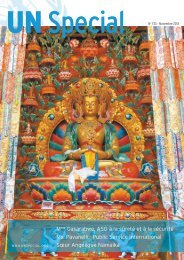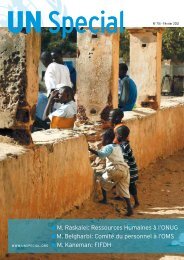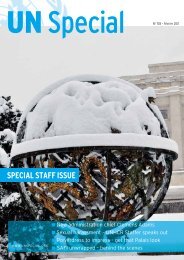PDF version - UN Special
PDF version - UN Special
PDF version - UN Special
- No tags were found...
Create successful ePaper yourself
Turn your PDF publications into a flip-book with our unique Google optimized e-Paper software.
SociétéTORTUREA DISGRACE TO ALL HUMANITYAlthough torture is a crime against humanity and civilization,prohibited by countless international and regional norms, andsubject of universal jurisdiction, it continues to occur in manycountries in the world.ALFRED DE ZAYAS, OHCHR RETIREDManfred Nowak, the Human Rights Council’s<strong>Special</strong> Rapporteur on Torture, has recentlypublished a thorough Commentaryon the United Nations Convention againstTorture (http://www.hrweb.org/legal/cat.html, adopted by the General Assembly on10 December 1984, in force 26 June 1987).This is one of the seven core <strong>UN</strong> humanrights conventions and is administered bythe Committee Against Torture, which wasestablished in 1987 and is composed of tenindependent experts. As of November 2009there are 146 States parties to the Convention,which unfortunately means that it isnot universally applicable, since forty-sixStates members of the <strong>UN</strong> have not yet adheredto it. The Committee meets twice ayear in Geneva and is serviced by the Officeof the <strong>UN</strong> High Commissioner for HumanRights.The principal functions of the Committeeconsist in the consideration of periodic Stateparty reports and the examination of individualcomplaints. It is the latter activity thathas proven most innovative in creating jurisprudenceconsistent with the case-law producedby the <strong>UN</strong> Human Rights Committee,by the <strong>UN</strong> Committee on the Elimination ofRacial Discrimination and by the <strong>UN</strong> Committeeon the Elimination of DiscriminationAgainst Women. Precedent goes beyond themere reaffirmation of norms and constitutesin a very real sense living law, since Committeedecisions identify concrete violationsof the norms with respect to real persons,make specific findings and propose solutionsthereon. Moreover, precedent has apreventive component, because by applyingthe law in concrete cases, all governmentsand law enforcement officials knowwhere the limits are, what is allowed, whatis not, and what are the consequences ofviolations.Perhaps the most considerable breakthroughin the jurisprudence of the CommitteeAgainst Torture concerns the applicationof article 3 of the Covenant whichprovides: “No State shall expel, return orextradite a person to another State wherethere are substantial grounds for believingthat he would be in danger of being subjectedto torture”. On its face this merelyrepeats the principle of non-refoulement,which we already know from the GenevaConvention on the Status of Refugees. Butthe Refugee Convention did not envisagethe establishment of a “Committee on RefugeeStatus” competent to monitor compliancewith the Refugee Convention. Thus,in the absence of such a special committee,CAT has assumed some responsibilities inthis connection. Admittedly, CAT cannotapply or interpret the Refugee Convention,but it can and does interpret the ConventionAgainst Torture broadly enough so asto prohibit the deportation of many asylumseekers and persons in refugee-like situations.Article 3 of the Convention has thusbecome the backbone of the Committee andhas allowed it to extend protection to a significantnumber potential victims of torture.80% of the individual cases submitted tothe Committee concern alleged violations ofthis article. Nowak devotes 102 pages to thediscussion of this provision (pp. 127-228)In many ways Nowak’s book illustrateshow international law and in particular theConvention against Torture are relevant toall of us. It has played a hugely importantrole in the struggle against impunity, e.g.in connection with the detention of formerChilean President Augusto Pinochet whoseclaim of “immunity” on the “act of State”doctrine were rejected by the House ofLords.Urgent action is frequently required butseldom possible. Notwithstanding the issuanceof “interim measures of protection” bythe Committee, States parties do not alwaysabide by them. Similarly, even when theCommittee has concluded consideration ofa case and issued a final decision on themerits, the State party does not always agreewith the Committee’s findings. This is whythe Committee has established a follow-upprocedure to persuade States parties to implementthe Committee’s recommendations.Until States adopt enabling legislation thatwould give Committee decisions status inthe domestic legal order of States, enforcementwill continue to be fairly ad hoc.Nowak’s Commentary throws light on thedrafting history of the Convention (travauxpréparatoires), rules of interpretation, reservations,declarations to and denunciationsof the Convention and to its OptionalProtocol of 18 December 2002 (in force 22June 2006, fifty States parties, http://www2.38 – <strong>UN</strong> <strong>Special</strong> – Décembre 2009















